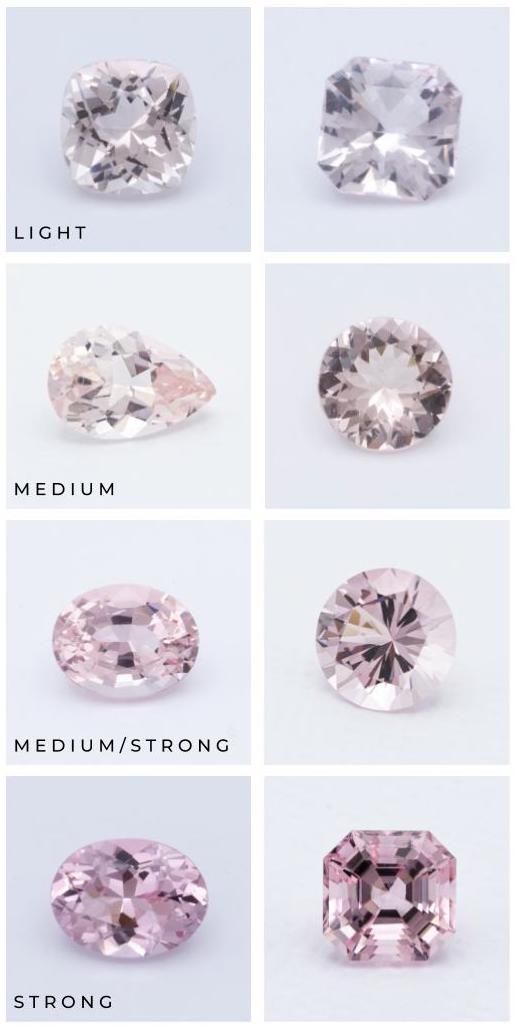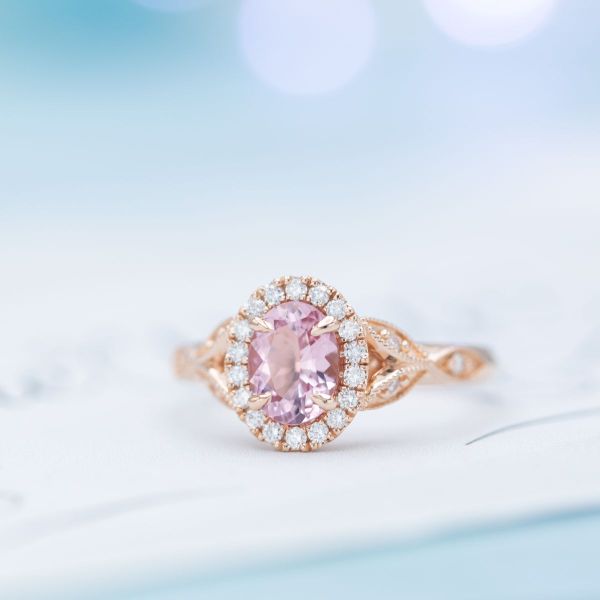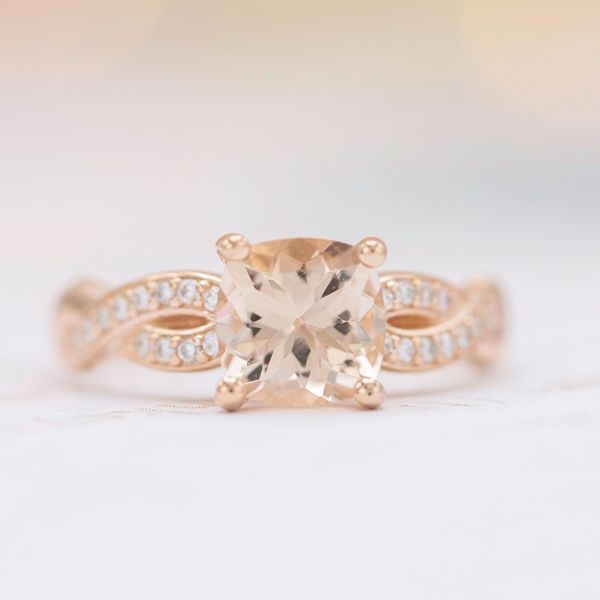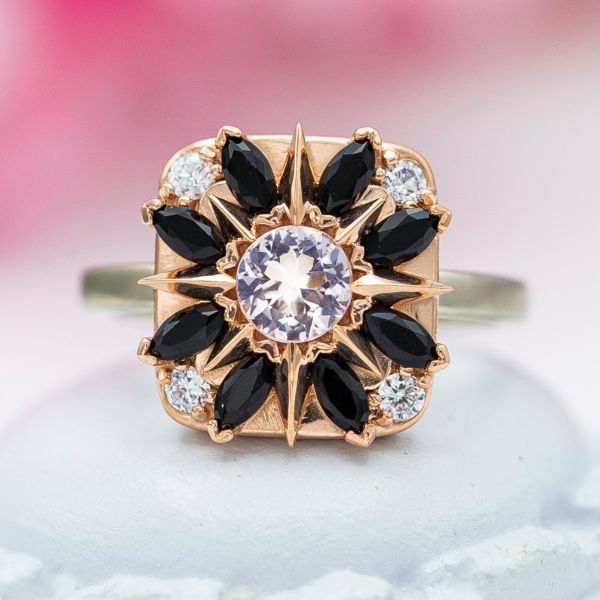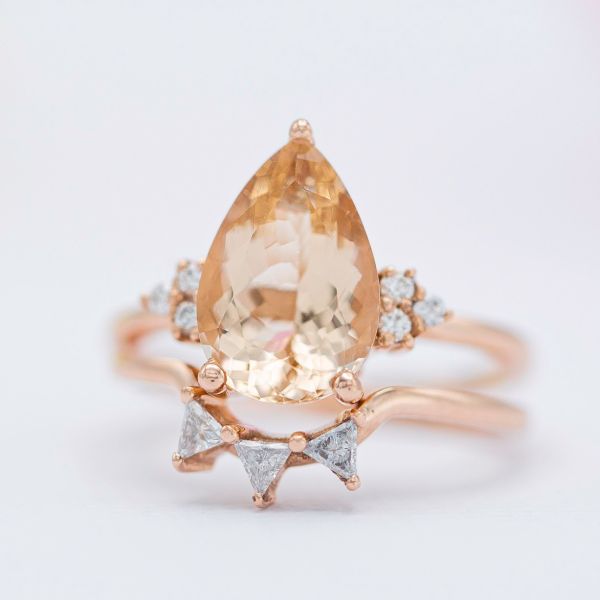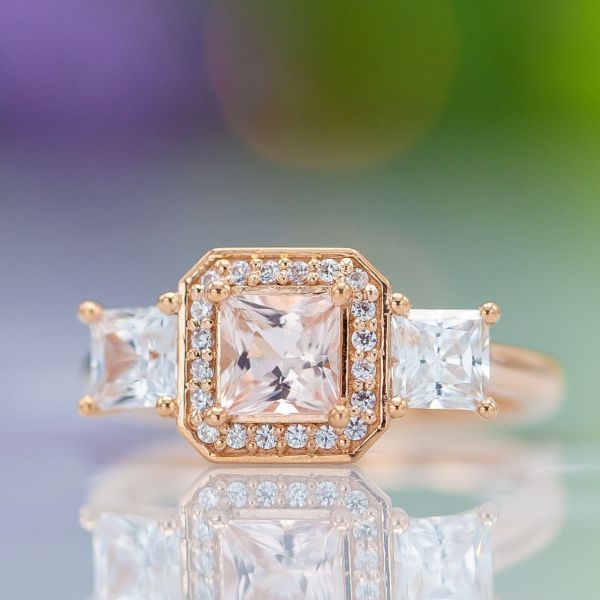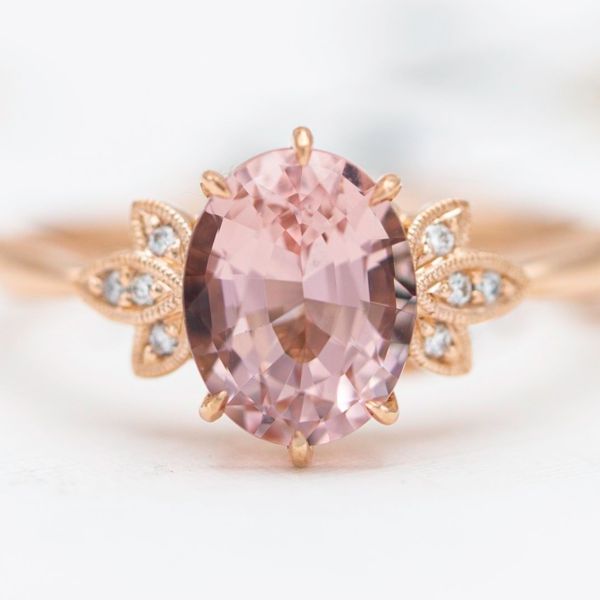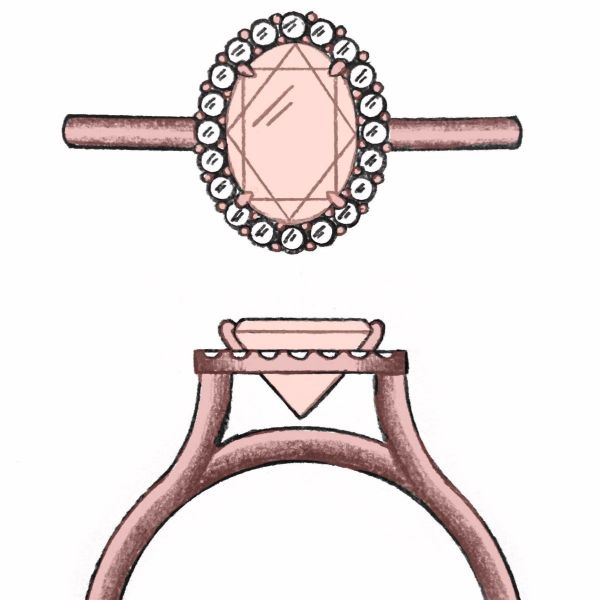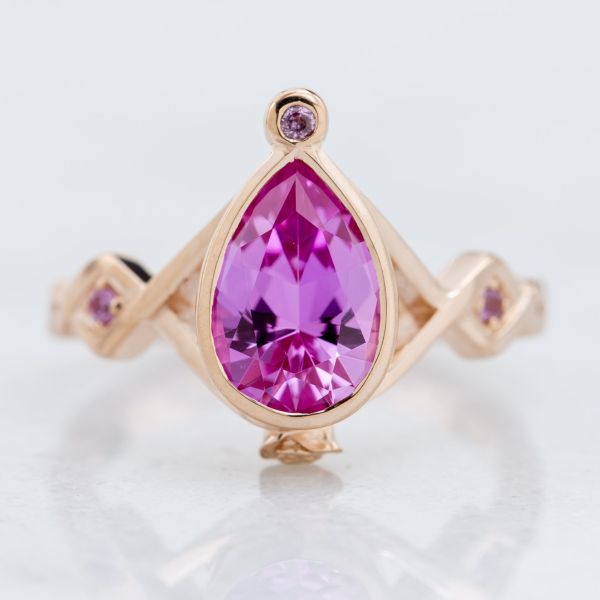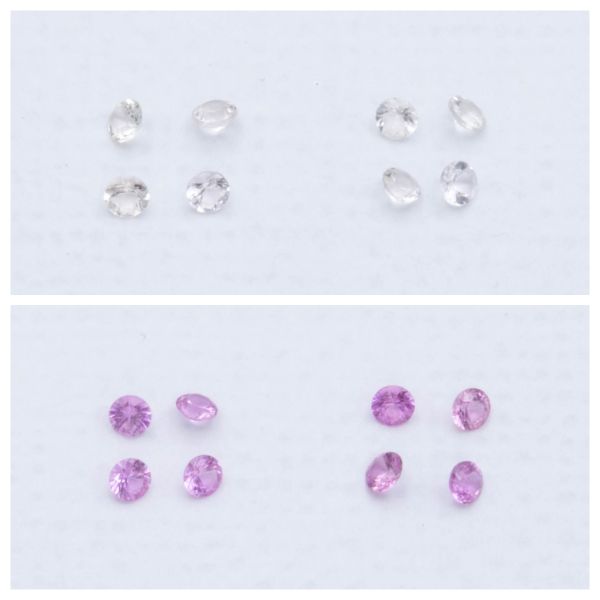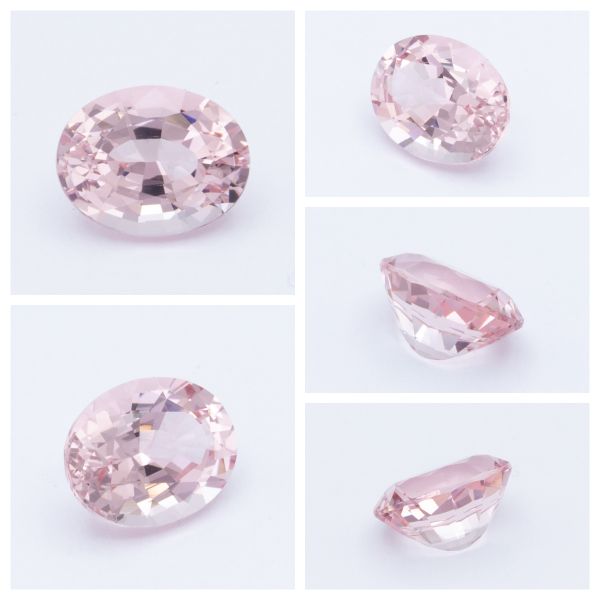Gemstone Knowledge
Morganite selection guide: color, cut, clarity, price, and more
A practical guide to choosing the best morganite for your engagement ring
Choosing your morganite
If you're thinking about how to pick out a morganite, you've probably already fallen in love with its color. You may even have some ring designs in mind. You don't want any old morganite — you want one that's perfect, so you probably have a few questions:
- How do I make sure I get the right shade of pink or peach?
- How much does morganite cost?
- What size morganite should I get?
- Is there anything else I should worry about — like clarity or treatment?
In this guide, I'll explain how to choose a morganite like an expert. There's nothing more important than color selection, so we'll start there.
Color
Color shade
Morganite comes in shades along the peach-pink color spectrum. Your first decision is whether you prefer a look that's more peachy, more pink, or something in-between. Gem experts refer to this aspect of gemstone color as hue. Stones with pink hues are typically priced a bit higher than peach hues, but both colors can make a great look for your piece. Peachy pink options are the most popular, but we sell a fairly even balance of each shade.
Color saturation
Choosing color shade is enough for some customers, but if you really want to understand the nuances between different morganites, you need to consider color saturation. Saturation measures color intensity, with more intense colors referred to as strong or vivid and milder colors referred to as light. Just as there's no ideal shade, there's no ideal saturation. Pink stones with vivid colors tend to be the most valuable, but what's best for you comes down to your personal preference. Some customers are looking for a light champagne peach, while other customers want a strong pink. The morganite color chart below give you a sense of the range that's available from light to strong saturation.
Specifying your color preference
Now that you understand shade and saturation, you can let our gem experts know what you're looking for. To talk like an expert — specify the color by saying the saturation first, then the color shade. That's true whether you want a medium peachy pink, a vivid pure pink, or a light peach.
Shape
Once you have your color picked out, it's time to move on to choosing the right shape. Morganite is a versatile stone that can look great in a variety of shapes. The most popular choices are oval, cushion, round, and emerald cut — but we also offer pear shape, radiant cut, marquise, trillion, asscher cut, heart shape, princess cut, and more.
Light moves through each shape differently, impacting the perceived color saturation. Rounds are popular for diamonds because they are the best at returning white light that hides color, making diamonds look even more colorless. Shapes other than round (known as "fancy shapes") are popular in colored gemstones because they amplify color, making the stone look more vivid. That's one reason why ovals and cushions are such popular morganite choices.
Size
Now that you know color and shape, it's time to choose your size. Don't be afraid to think big! We most commonly sell morganite center stones in the 1.5-2.5ct range. 3ct+ stones aren't unusual and, of course, we have options at 1ct and below for customers that want a subtler look. Large morganites are popular for two main reasons:
- Larger sizes become more rare in most gemstones, but morganite frequently grows in large crystals, making large sizes relatively affordable, especially when compared to large diamonds
- If you cut a large and a small morganite from the same crystal, the larger morganite will showcase more vivid color because there's more gemstone for the light to travel through and strengthen the color. Given morganite is a light stone, this means larger stones can help to provide stronger color saturation.
Price
Alright, now you know what you want. How much will it cost? Despite growing popularity, morganite remains great value. Most of our customers end up spending $300-950 on their morganite. 0.5-1ct stones in lighter color saturation are at the bottom of the range and 2ct+ stones in vivid pinks are at the top of the range. 2.5-4ct stones can be a bit more, typically costing $800-1800.
We work directly with morganite cutters to offer top-quality morganite at great prices. By eliminating middlemen, we're able to offer exceptional value straight from our private collection.
Other factors to consider
Cut
If you've read our diamond guides, you may be surprised that cut wasn't mentioned earlier. Cut is important for morganite, but not as central as it is for diamonds. Diamonds are all about sparkle and there's a science behind the best cut. Colored gems like morganite are all about color, and cut can differ stone to stone in order to best showcase the color of that crystal. With diamonds, it's critical to have an official grading report and an excellent cut grade. With morganite and other colored gemstones, cut grading hardly exists.
What's that all mean for you? Pay attention to how each morganite looks to your eye — make sure it's lively and symmetrical. Beyond that, you can leave it to our gem experts to worry about more technical cut issues like windowing (light passing through) or extinction (light getting "stuck" and leaving dark sections).
Clarity
Given morganite's light color, it's important to avoid inclusions in the stone that are eye visible. Fortunately, morganite often naturally forms in clean crystals that make great gemstones — so clarity is rarely a concern.
Colored gemstones are typically evaluated on whether or not that are eye clean, meaning free of imperfections visible to the naked eye. Unlike diamonds, a clarity scale with specific ratings (e.g. VVS, VS, SI) is not typically used for morganite, nor is it required. You can expect all morganite options we show you to be eye clean.
Setting styles
Morganite is versatile, so you should feel free to consider a wide range of styles. If you aren't sure exactly what you want, we recommend two popular options:
- Rose gold settings look great with morganite because the metal color reflects off the stone, amplifying its pink color.
- Diamond halos and diamond accent stones offer another way to enhance the look of a center morganite. The colorless diamonds create eye-catching sparkle and visual contrast that highlights the color of the morganite center stone.
Treatment
Nearly all morganite is heat-treated at the mine or before cutting to enhance its color. The heating mimics what happens naturally during gem formation. It permanently reduces yellow undertones that make morganite appear peachy, leaving a purer and stronger pink that commands a higher purchase price than if it were untreated. The treatment isn't detectable in morganite with current gemological techniques. Heating is common practice with colored gemstones and isn't something that should concern you when purchasing your morganite.
We encourage you to ignore heat treatment in morganite and stay focused on factors that impact appearance like color and size.
Morganite alternatives
Pink Sapphire offers stronger color
Morganite comes in popular colors, at a reasonable price, with great wearability so it's rare that customers look for alternatives. The main reason to look at other stones is for more vivid color. Even a highly saturated morganite is light in color relative to gemstones that can reach more intense color shades like emerald, ruby, and sapphire. We recommend pink sapphire for customers that want a more vivid pink option. Note that pink sapphire is slightly purplish pink rather than the pure pink or peachy pink that's found in morganite. But, much as we love sapphire, morganite is the more popular choice. This is an alternative we mention only for those customers that want an extra strong pink.
Morganite is too light for small accents
All gems tend to get lighter as they get smaller. A light gem like morganite tends to look so light at small sizes as to appear nearly colorless (like the top row of the image below). For customers looking for light pink accents, we recommend getting a lighter tone of pink sapphire (like the bottom row in the image below). Morganite is an excellent center stone, but we generally don't recommend it for small accents.
Review individual stones
We've covered a lot here about what's important in a morganite. This may be obvious, but to choose the right stone it's critical to review high resolution images of your exact morganite! Make sure you're selecting your individual stone, not buying off of a stock photo.
We photograph our morganites in a controlled lighting environment designed specifically to capture gemstones with true-to-life color. That way you can determine the shade and the saturation of pink that's right for you. Our gem specialists often talk to customers about spotting "the one" — because, once you've considered color and shape and size and budget, what ultimately matters is which one catches your eye and feels like the perfect morganite for your ring!
About CustomMade
CustomMade designs and creates one-of-a-kind, custom engagement rings and fine jewelry. Each piece we create is inspired by you, designed for you, and made just for you.

